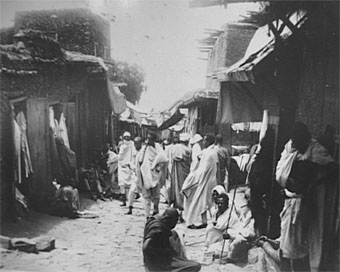| Home Harer the medieval wall city The History Updated 15 Feb 2006 | Page 15 | |
Harer the medieval walled city
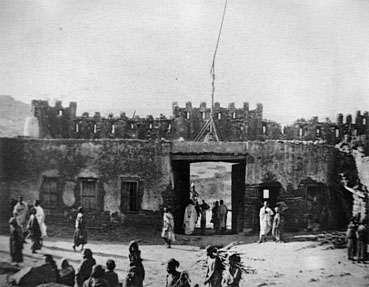 'Assum
Bari' one of the 5 gates in Harer at 1897
'Assum
Bari' one of the 5 gates in Harer at 1897
|
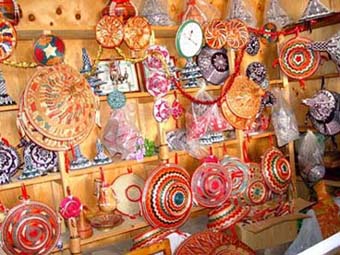 Hareri handmade Baskets
Hareri handmade Baskets
|
|
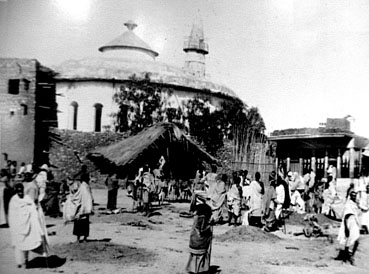 Medane Alem ready after construction at
1895
Medane Alem ready after construction at
1895
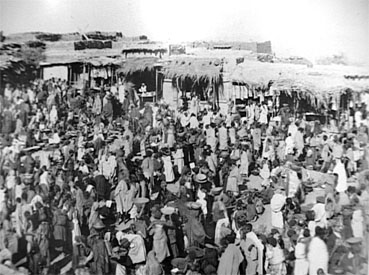 The
'Megala
Kudo' market in Harer at 1907
The
'Megala
Kudo' market in Harer at 1907
|
Nobody is certain at what
period Harer was established. It could be that merchants from neighboring
Yemen, following the trade route and taking advantage of the natural
location, an elevated plateau surrounded by mountains with an easy access
to the coastal line, settled there as a midway stop between southern
Arabia and the Ethiopian highlands.
Most historians agree that around the 7th
century an early settlement was established there. During
the 10th century the Makhzumi sultanate was established in Shoa.
At 1285 it was conquered by Wali Asma having a distiguist Arabic ancestry.
It was named the ĎWalasma dynastyí. While Wali Asmaís successors
were expanding to the East, they established the sultanate of ĎIfatí. During
the reign of Amde Tseyon, hostilities started between Ifat and the
Christian kingdom resulting to the defeat of its Muslim leaders. Later on
their sons created the sultanate of Adal and established their capital
Dakar in the vicinity of todayís Harer.
Prosperity came for the sultanate of Adal mainly through trade but
fighting started with the highlands kingdom again. Around
1445 sultan Badlayudi was defeated by the emperor Zara Yakob and the
Adalites had to retreat. At
1468 the sultan,ís son and successor Mohamed started trade having good
relations with the kingdomís Baeda Mariam.
But after Mohamedís death, conflict stirred up again and Baeda
Mariam moving his base to the Gourage province, fighting started in Dawaro
and Bale. At 1478 Baeda Mariamís 6 year old successor Iskinder, accented to the throne and the Queen mother Eleni, an influencial and capable woman, being the regent of Iskinder as well as to his successor Naod (1494-1508) Baeda Mariamís second son . She was aware of the wider Muslim world and try to achieve good relations with Adal. |
Back to: Harer main page Flora & Fauna Harer surroundings
|
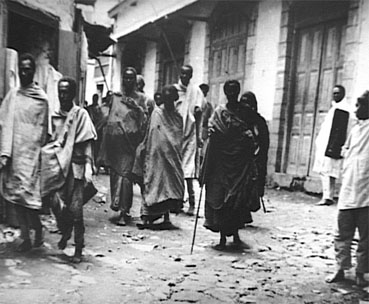 Street
scene in Harer at 1920
Street
scene in Harer at 1920
|
 Click here for info
Click here for info
|
|
|
 Dedjazmatch
Imerou and accompanying party ( 1920 )
Dedjazmatch
Imerou and accompanying party ( 1920 )
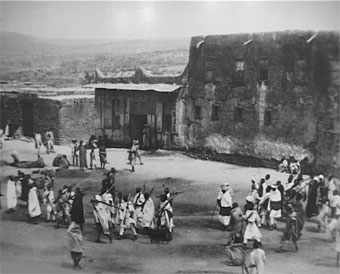 Ato Markan, a police chief and
his guards in Harer at 1898
Ato Markan, a police chief and
his guards in Harer at 1898
 Ras Tafari Makonen when he was 18 years
old
Ras Tafari Makonen when he was 18 years
old
|
Sultan
Mohamed (1488-1518) who reigned there for 40 years, was agreeable with her but the
Emir of Harer Mahfooz who was wedging war against the Kingdom. At
1508 Naodís reign came to an end after he was killed in Ifat campaigning
against the Muslims. His son Lebna Dengel was only 7 years old when he had
to rule with Eleni being again his regent. She had foresight and in order
to match the help the aid the muslim state received from Arabia send
Mateus an Armenian emissary to Portugal asking for support. He reached the
royal court of king Manoel on 1514 but it took until 1520 until the
Portuguese send a mission to Ethiopia. Meanwhile
at 1516 emir Mahfuz invaded the highlands and Lebna Dengel in a successful
ambush slew him and chased his army back to their territory. At
1520 a young warrior, Ahmed bin Ibrahin, otherwise known Gragn the
left-handed, after assassinating Adalís sultan Abu Baker started new
attacks on the kingdom from Harer.
Grangís vision was to conquer the Christian kingdom. At 1529 he inflicted a heavy defeat for Debna Dengelís forces and again at 1531 he started a new and well planned invasion of the highlands. Burning Churches and forcibly converting any captured Christians to the Moslim faith. Scholars write ďGragn campaigns destroyed Ethiopiaís literary, architectural and cultural heritageĒ At
1540 Emperor Geladewos (Claudios) at 18 he ascended to the throne and
although in a grim situation he marched his people and soldiers to fight
the enemy.
|
|
 Assum
Bari' one of the 5 gates in Harer
at
1897
Assum
Bari' one of the 5 gates in Harer
at
1897
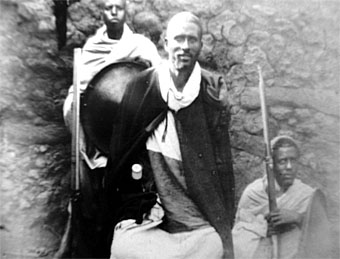 Men after the capture of Harer 1885
Men after the capture of Harer 1885
 Medane Alem ready after construction at
1895
Medane Alem ready after construction at
1895
 in
A street scene in Harer at 1907 in
A street scene in Harer at 1907
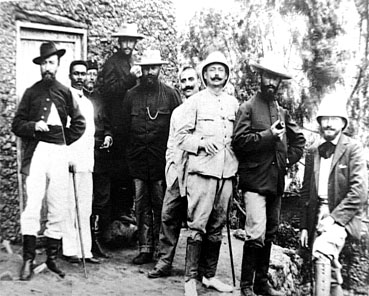 Foreigners in Harer. This
picture was taken in front of the French Consul's house at 1897
Foreigners in Harer. This
picture was taken in front of the French Consul's house at 1897
 Ato Markan, a police chief and
his guards in Harer at 1898
Ato Markan, a police chief and
his guards in Harer at 1898
|
Ethiopian warriors joint them and moving their way through Tigray engaged Gragnís armies several times and making good advance using effectively their European weapons. Gragn was alarmed and requested help from the Turks which in response send him 900 men reinforcements. At that point near Lake Tana the Portuguese were surrounded by Gragnís forces and they captured 120 men killing Da Gama. Geladewos
used of some quantities of hidden
weapons in Debre Damo earlier and producing locally gunpoweder! Then with
the help of the remaining Portuguese, on February 1543 took Gragnís
forces by surprise again by Lake Tana while the Portuguese fought
ferociously avenging the killing of their leader Da Gama. Reportedly a
musketeer single handedly At
1550 he build the historic wall with battlements around the city of Harer
they are still an impressive site up to our days! At 1647 Harer an indigenous dynasty was founded by Ali bin Daud lasting over two centuries. The Emirs kept busy in one hand fighting and on the other converting them to Islam. Later on, as Harer was situated ideally between the Highlands and the coastal line, trade was improving and Harer gradually developed to a commercial city. Foreigners especial Christians were not allowed to enter the city. A British traveler and explorer Sir Richard Burton at 1855, was the first person to visit Harer disguised as a Muslim merchant. He stayed there for 10 days and later published at 1856 the ĎExploration of Harerí from which we have learned the everyday life of the city at that time! At 1875 after killing its emir Amit Abdul Shakur, Egyptian army captured Harer. At that time the city ceased to be an independent city state and it opened its gates for foreigners. During that time, Arthur Rimbaud, the flamboyant Parisian poet, abandoned the life of Parisian literary circles to settle in an adventurous lifestyle in Harer! A decade later at 1884, the Egyptian plans for an ĎEst Afrikan empireí collapsed and they left Harer. Emir Abdalah expelled once again all foreigners but had to confront king Menelik from Shoa and on January 1887 was defeated at the battle of Tchelenqo. Soon after Harer was annexed to the Ethiopian empire and Menelik appointed his cousin, Ras Makonen father of Ras Tafari, later to be emperor Heile Selassie, governor of Harer. The local administration was given to the nephew of the emir he had defeated. In
1907 the operation of the newly build railway line between Addis Abeba
and the port of Djibuti created a new city Diredawa. This changed
the trade route entirely and Harer changed for ever. At
1925, an other European visitor Rosita Forbs visited Harer while Ras
Tafari was ruling there and se wrote a descriptive book, from the Red sea
to the blue Nile. She also warned the authorities of an eminent Italian
invasion! At
1935 the Italian forces entered Harer. During their stay, Italian
engineers restored the ĎBadri Barií one of Harerís 5 gates looking
to the South West. Harer was again in danger: just after 1977 under the rule of Siad Bare, Somalian forces invaded the Ogaden. Not far from Harer and outside Jijiga at a decisive tank battle the Somali forces suffered a humiliating defeat and retreated.
|
|
